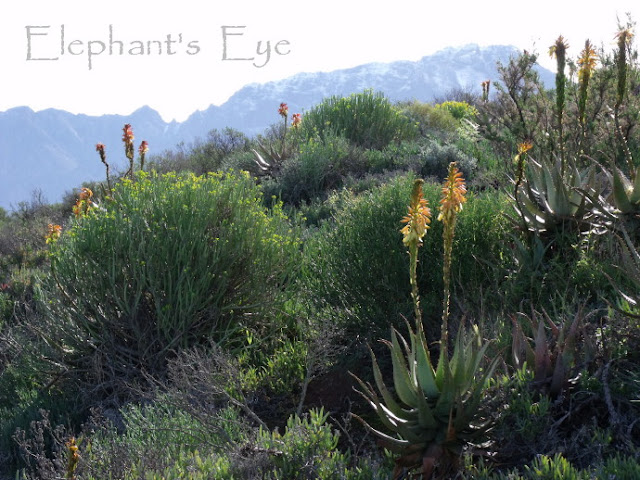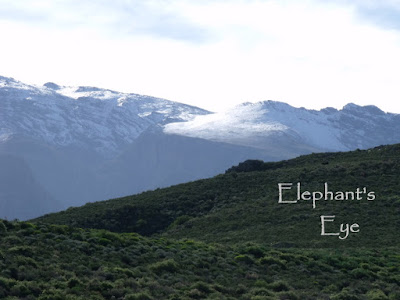Where the aloes live, on a Karoo Koppie
by Diana Studer
- gardening for biodiversity
in Cape Town, South Africa
When we travelled towards Worcester in July 2010, to the Karoo Desert National
Botanical Garden, we left Porterville's wheat-fields with their isolated
pockets of Renosterveld. At the foot of the Mostertshoek Twins 2030m we
saw the sunshine bush – golden leaves on the Leucadendron proteas.
Lighting up the fynbos slopes of the mountains, then winding away along
the road not taken, to Bain’s Kloof Pass. To the Little Karoo.
Semi-desert, because it does get a little rain, now in the winter.
We earned our lunch. Sitting on the
terrace, looking across the garden, aloes blooming, snowy mountains in the
distance. Cupcake, one of those tiny fluffy Yorkshire terriers, bounding across
the lawn.
What lit up this garden, beneath the flaming torches of the
aloes, was the chartreuse-gold of Euphorbia mauritanica NOT from the
Moors in ancient Mauretania, but from South Africa and Namibia). Grey leaves
and white flowers of wild rosemary. A little pink-and-white-prettiness Crassula
has two tone leaves, supporting those flowers. Feathery mauve Felicia,
not the commonorgarden kingfisher blue. (Wakes up in yellow pyjamas, and only
puts its mauve dress on, when the sun comes out!) In the path, the first of the
pink Oxalis.
Nature weaves a tapestry of textures. The thick trunk with
fleshy luminous green leaves, just in winter, is the botterboom - happy to tick this one off my list for the
False Bay garden. With blue-grey leaves edged with burgundy
from Cotyledon orbiculata.
This landscape is covered with an understory beneath the
trees and the tall aloes of Karoo bossies, like wild rosemary, which are
eaten by the sheep. Giving Karoo lamb which is famous (but not to these
vegetarians). In a harsh climate, people survive by farming sheep.
I think that spotted leaf is the Worcester aloe (Spotted Aloe
microstiga from their nursery went to Porterville). The aloe flowers are
probably Aloe ferox, which has green leaves, no spots.
Along the rocky path, where they benefit from the trickle or
flow of water in winter, but risk hikers boots, there are bulbs. A brave bud
just starting to show its head. And despite that semi-desert climate, in
winter, there is moss and lichen, in shady places.
This, is a Karoo Koppie. A rocky outcrop, with its
own particular community of plants. (Inspiring our Karoo
Koppie in Porterville and again on False Bay)
If you grow small succulents, Haworthia or Gasteria,
remember that although they come from a hot dry climate – when they are at
home, they grow like this. In the shade of a small twiggy bush. Tucked in under
the canopy, where leaf litter gives them a little nourishment, and the sun,
cannot quite reach them.
The bush might be, as this one is, wild rosemary. But daisy,
not sage, family. Eriocephalus. Grey leaves. China white flowers which
cover the bushes. A tiny knee high light house. If you click on the flower
detail, you will see the seed-heads developing. Tiny feathery cotton-bolls will
cover the bushes in a second wave of white, after the flowers have faded. See
those delicate burgundy markings on the flowers?
Hike up and around the Koppie. The Ungardener panting
from the exertion, and my stiff legs, reminded us that we are not fit.
Pictures by Jurg and Diana Studer
of Elephant's Eye on False Bay
(If you mouse over teal blue text, it turns seaweed red
Those are my links.
To read or leave comments, either click the word Comments below,
or click this post's title)
Pictures by Jurg and Diana Studer
of Elephant's Eye on False Bay
(If you mouse over teal blue text, it turns seaweed red
Those are my links.
To read or leave comments, either click the word Comments below,
or click this post's title)











I have never saw the flower of the Aloe, its amazing,,, the land looks quite arid, beautiful landscape and brought to life even more so than the photos with your beautiful narration,
ReplyDeleteI visit when I can hope for snow on the mountain and aloes in flower.
DeleteYou are fortunate to be able to hike comfortably even in your winter! The Wild Rosemary is lovely.
ReplyDeleteand to come home to a warm house filled with sunshine today
DeleteBeautiful images, Diana. I loved seeing the aloes bloom in the winter when I lived in California. xo Laura
ReplyDeleteI am hot and tired too...did you bring some lemonade??? :)
ReplyDeleteHow beautiful the scenery is on this hike...
(I've never made, or drunk, lemonade. But I have been filing away recipes. I always walk with a bottle of filtered water from home.)
DeleteI did not know that aloe bloomed! What a beautiful landscape.
ReplyDeleteI so much associate blazing red torches of aloe flowers with driving across the Karoo in winter. Fireworks!!
DeleteSeeing what are houseplants for us in their natural habitat is a special treat.
ReplyDeletea little like visiting a friend at home
DeleteI am continually fascinated how one country's tame houseplant is another's wild one.
DeleteDiana, I am again impressed with the part of world in which you live. A tapestry of textures indeed!
ReplyDeleteIt is this green carpet that protects our earth.
ReplyDeletethese plants remind me of the flora I saw in the Flinders Ranges, probably similar climate. There were Aloes that had gone wild in the caravan and camping park, and they looked horribly out of place there. To see yours in their proper habitat is a joy. And there were daisy bushes like the wild rosemary. This post makes me feel restless, wanna go back to the bush for a nature fix ...
ReplyDeleteThe Eucalyptus trees on farms feel like ours. But the bottlebrush does look alien. When I see Port Jackson seedlings my fingers itch to pull up unwanted invaders.
DeleteAre those aloes at the campsite originally planted as garden specimens? Or simply invasive?
they were planted as garden specimens. They've spread at the camp site, luckily I didn't see any in the bush outside.
DeleteSeeing all those beautiful colourful plants makes the word desert strange ...
ReplyDeleteNamaqualand and the Karoo - I expect my deserts to make flowers in their season. But it is amazing, if you can stop, and walk, how much there is to see.
DeleteThat's a fascinating landscape! I didn't know about these plants.
ReplyDeleteRegards
Elke
That does look like a hard landscape to live in, but love all the little living treasures you pointed out! That explains why one of the succulents I was trying to grow really wants more shade, not full sun. And love all the lichen growing there where it can!
ReplyDeleteWhen I was younger, and less appreciative, I used to hate seeing aloe plants. Now, that I am older and wiser, I appreciate it for it's different beauty, and water-wiseness.
ReplyDeleteIt's amazing anything grows in such a difficult environment. It makes you respect the plants who do make that area their home all the more.
ReplyDeleteand watch in quiet admiration as my succulent garden LUSHes out.
DeleteMore fit than me I suspect....love these excursions into your fascinating wild areas...wild rosemary...love it!
ReplyDelete